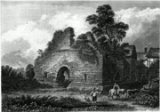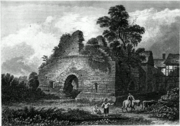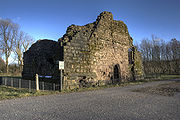
Radcliffe Tower
Encyclopedia


Radcliffe, Greater Manchester
Radcliffe is a town within the Metropolitan Borough of Bury, in Greater Manchester, England. It lies on undulating ground in the Irwell Valley, along the course of the River Irwell, south-west of Bury and north-northwest of Manchester. Radcliffe is contiguous with the town of Whitefield to the...
, Greater Manchester
Greater Manchester
Greater Manchester is a metropolitan county in North West England, with a population of 2.6 million. It encompasses one of the largest metropolitan areas in the United Kingdom and comprises ten metropolitan boroughs: Bolton, Bury, Oldham, Rochdale, Stockport, Tameside, Trafford, Wigan, and the...
. It is a Grade I listed building and a Scheduled Monument. The house was rebuilt in 1403 by James de Radcliffe, who was lord of the manor
Manorialism
Manorialism, an essential element of feudal society, was the organizing principle of rural economy that originated in the villa system of the Late Roman Empire, was widely practiced in medieval western and parts of central Europe, and was slowly replaced by the advent of a money-based market...
of Radcliffe, and consisted of a stone-built hall and one or two towers, probably built with ashlar
Ashlar
Ashlar is prepared stone work of any type of stone. Masonry using such stones laid in parallel courses is known as ashlar masonry, whereas masonry using irregularly shaped stones is known as rubble masonry. Ashlar blocks are rectangular cuboid blocks that are masonry sculpted to have square edges...
blocks. De Radcliffe was given a licence from the king to fortify the site including adding crenellations and battlements.
The manor house was demolished in the 19th century leaving only the tower. The tower measures by and survives to about in height. The remains are owned by Bury council. It was used as a pig sty before being restored. Radcliffe Tower is about south of Bury Castle
Bury Castle
Bury Castle is an early medieval moated manor house in Bury, Greater Manchester . It is listed as a Scheduled Ancient Monument. The manor house was built by Sir Thomas Pilkington – lord of the manors of Bury and Pilkington, and an influential member of Lancashire's gentry – in 1469...
, a late 15th-century moated manor house.
See also
- Castles in Greater ManchesterCastles in Greater ManchesterThere are nine castles in Greater Manchester, a metropolitan county in North West England. They consist of four motte-and-baileys, three fortified manor houses, a ringwork, and a possible shell keep. A motte-and-bailey castle has two elements, the motte is an artificial conical mound with a wooden...
- Grade I listed buildings in Greater ManchesterGrade I listed buildings in Greater Manchester-See also:*Architecture of Manchester*Conservation in the United Kingdom*Grade II* listed buildings in Greater Manchester*List of tallest buildings in Manchester*Scheduled Monuments in Greater Manchester-Bibliography:...
- Scheduled Monuments in Greater ManchesterScheduled Monuments in Greater ManchesterThere are 37 Scheduled Monuments in Greater Manchester, a metropolitan county in North West England. In the United Kingdom, a Scheduled Monument is a "nationally important" archaeological site or historic building that has been given protection against unauthorised change...

